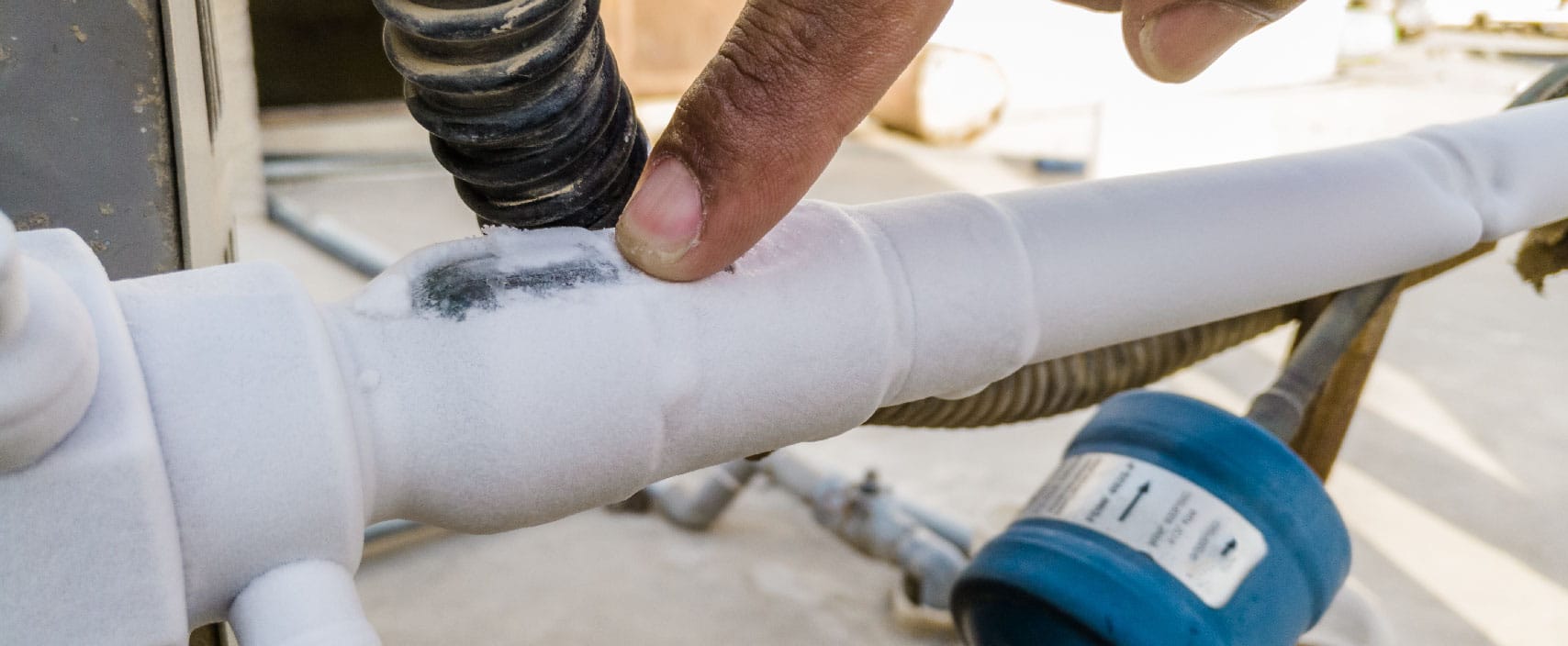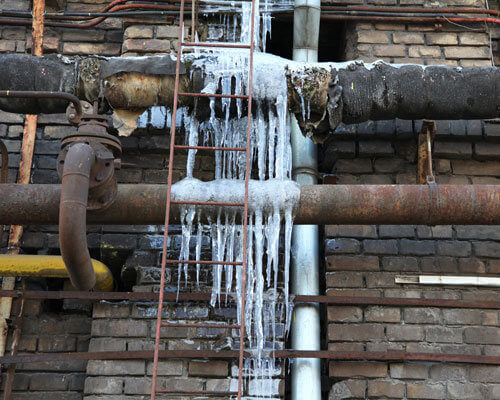Handling a Frozen AC Pipe - Guidance for Resolving the Issue
Handling a Frozen AC Pipe - Guidance for Resolving the Issue
Blog Article
This post down below relating to Why Is Ice On My Outside Air Conditione is immensely insightful. Read it yourself and see what you think of it.

Introduction
Finding that your air conditioner pipeline is iced up can be worrying, specifically throughout warm summertime when you rely upon your ac system the most. Understanding what to do in such a scenario is essential to prevent more damages to your cooling system and ensure your convenience inside your home.
Comprehending the Causes
Several elements can contribute to the cold of an air conditioning pipe. Comprehending these reasons can assist you deal with the problem efficiently.
Lack of Airflow
One typical root cause of an icy AC pipe is inadequate airflow. When the air flow over the evaporator coil is restricted, it can trigger the coil to go down below freezing temperature, bring about ice formation on the pipeline.
Low Refrigerant Levels
Inadequate cooling agent levels in your air conditioner system can likewise cause an icy pipeline. Low cooling agent degrees can cause the pressure in the system to go down, bring about the freezing of wetness on the evaporator coil.
Cold Weather Conditions
In chillier climates, freezing temperature levels outside can contribute to the freezing of AC pipes. If your AC system is not effectively protected or if there are leaks in the ductwork, cool air can infiltrate the system, creating the pipeline to freeze.
Dirty Air Filters
Filthy or clogged air filters can restrict air flow in your air conditioner system, resulting in numerous issues, including a frozen pipeline. It's essential to replace or clean your air filterings system routinely to make sure appropriate air movement and protect against ice buildup.
Signs of a Frozen AC Pipe
Recognizing the signs of a frozen AC pipe is vital for timely action.
Decreased Airflow
If you discover a significant decrease in air movement from your vents, it can suggest an icy pipe.
Ice Buildup on the Pipe
Visible ice buildup on the cooling agent line or the evaporator coil is a clear indicator of a frozen air conditioning pipeline.
Weird Sounds from the Unit
Unusual noises, such as hissing or gurgling, coming from your air conditioning device can signify that there's ice present on the pipe.
Immediate Actions to Take
When faced with an icy AC pipe, it's essential to act swiftly to stop further damage to your air conditioning system.
Switching off the a/c
The very first step is to turn off your air conditioning system to stop the system from running and aggravating the concern.
Looking for Blockages
Check the area around the indoor unit for any blockages that might be blocking airflow, such as furnishings or drapes.
Thawing the Pipe
You can use mild techniques like placing towels soaked in cozy water around the frozen pipe to aid thaw it slowly.
Safety nets
Taking safety nets can help stay clear of future incidents of an icy air conditioning pipe.
When DIY Methods Fail
If your efforts to thaw the pipeline or address other concerns are not successful, it's time to employ an expert.
Relevance of Hiring a Professional HVAC Technician
A certified HVAC technician has the knowledge and devices required to diagnose and fix issues with your air conditioner system securely and efficiently.
Normal Maintenance Checks
Arrange normal upkeep checks with a professional HVAC professional to guarantee that your air conditioner system is running efficiently.
Altering Air Filters
Regularly replace or cleanse your air filters to stop airflow restrictions and preserve optimal performance.
Protecting Exposed Pipes
If your a/c pipelines are revealed to cool temperature levels, consider insulating them to avoid freezing throughout cold weather.
Seeking Professional Help
If DIY methods fail to resolve the issue or if you're unsure concerning just how to continue, it's finest to seek assistance from a qualified HVAC specialist.
Conclusion
Dealing with a frozen AC pipeline can be an aggravating experience, yet understanding just how to respond can help decrease damages and restore comfort to your home. By recognizing the causes, acknowledging the indicators, and taking prompt activity, you can properly deal with the problem and protect against future occurrences.
Frozen AC Line: Why It Happens & What To Do About It
A frozen AC line can be a rather peculiar sight in a place like Phoenix, Arizona where nothing ever freezes. In this post, we’ll discuss what makes an air conditioner line frozen – and what you can do about it.
Dirty Air Filters
Did you know that you should be cleaning or replacing your air filters on a monthly basis? Failing to do this can result in airflow issues that, in turn, cause your evaporator coils and lines to freeze over. You’ll notice a buildup of ice on both components, although the buildup on your pipes will, of course, be more evident unless you open your air condition up to reveal the coils.
What To Do About It
Give your air filter a good cleaning if it’s reusable. If not, replace the filter outright. Next, switch your air conditioner’s fan setting on and leave it there for 2-3 hours. This will draw warm air in, helping to thaw your evaporator coil. You can also check out this article for some tips on cleaning the coils themselves if you’d like to speed the process up. Before you switch the unit back to its normal state, make sure the supply vents are completely unobstructed and free of dust or other debris.
If you keep having this issue even after replacing your filters regularly, contact a local HVAC repair company and have them inspect your evaporator coil, ductwork, and any other components that may be at fault. If you live in the Phoenix, Arizona area, give American Home Water and Air a call.
Low Refrigerant Levels/Leakage
What To Do About It
Contrary to what air conditioner “recharge” companies often tell their clients about refrigerant, it should never need to be simply refilled. You see, refrigerant runs in what experts refer to as a “closed loop.” Refrigerant really shouldn’t be leaving that loop. If it is, you’ve got a leak.
Paying someone to come and pump more refrigerant into your system (aka “recharge” it) isn’t the solution. Doing that will simply kick the can down the road. Besides, refrigerant leaks can be harmful to the environment and people in your home.
Rather, you need to take care of the leak with the help of a technician. Check out this article for some more information about dealing with air conditioners that are leaking refrigerant. Before you contact a technician, switch your thermostat to the off position. Then, switch the fan setting on and let it run for 2-3 hours so the unit can thaw.
Improper Temperature Setting
Improper temperature settings can also cause a drop in your air conditioner’s pressure. What many people don’t realize is that air conditioners are actually designed to run when temperatures have fallen above roughly 60 degrees Fahrenheit. If you run the unit when it’s cold outside, you’ll run into many issues, including frozen components.

We were introduced to that article about How can I fix an air conditioner’s frozen pipe? from an acquaintance on another domain. Do you know about another individual who is fascinated with the niche? Why not promote it. Kudos for your time. Don't hesitate to come by our website back soon.
Course Detail Report this page